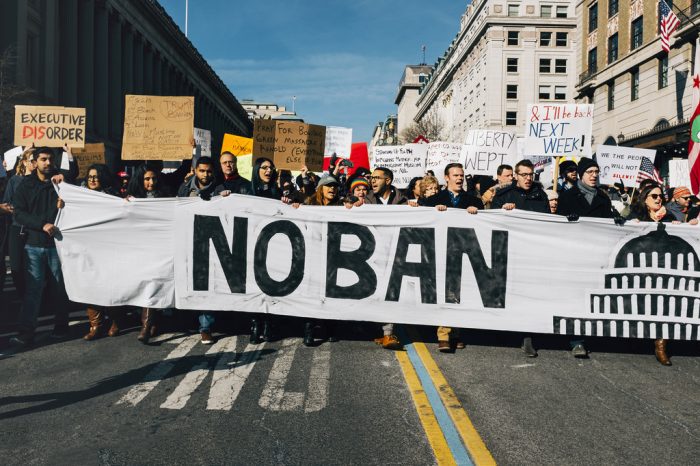From: https://www.lawfareblog.com/travel-ban-update-ninth-circuit-holds-eo-3-exceeds-presidents-power
On Dec. 22, the Ninth Circuit Court of Appeals ruled in Hawaii v. Trump that the September Proclamation (EO-3), indefinitely limiting immigration from certain listed countries, exceeded the President’s power under the Immigration and Nationality Act (INA). (For more context, read my earlier post on the Ninth Circuit oral argument here.) The per curiam decision modeled the thoughtful “common sense” approach to statutory interpretation that the Supreme Court urged in FDA v. Brown & Williamson. Adopting that common sense reading, the Ninth Circuit panel, comprised of Judges Ronald M. Gould, Michael D. Hawkins and Richard A. Paez, rejected the government’s uncabined construction of one INA provision, 8 U.S.C. 1182(f), which gives the President power to bar the entry of foreign nationals “detrimental to the interests of the United States.” The Ninth Circuit stayed its own decision, thus teeing up review by the Supreme Court in 2018.
As the Ninth Circuit noted, Brown & Williamson’s common sense standard rejects reading a statutory provision such as 1182(f) in isolation. Instead, a court should construe that provision in light of the INA’s language, legislative history and overall scheme. Other key elements of the INA include reliance on consular officers’ knowledge of country conditions, the abolition of national origin quotas in 1965, and Congress’s enactment in that year of a provision—8 U.S.C. 1152(a)(1)(A)—barring national origin discrimination in the issuance of immigrant visas.
In its strongest criticism of the government, the court rejected the government’s argument that EO-3 was not reviewable at all. Rejecting this assertion of nonreviewability, the panel cited to the Supreme Court’s decision in the 1993 case Haitian Centers Council v. Sale, in which the court found that the president had authority to interdict inadmissible foreign nationals navigating the high seas in unsafe vessels. Despite the government’s assertion that it lacked jurisdiction, the court reached the merits in Sale. Finding that EO-3 was reviewable, the Ninth Circuit warned that accepting the government’s assertion in this case would mean that the executive branch, “at any time and under any circumstances, could bar entry of all aliens from any country” without judicial review. That position, the Ninth Circuit warned, would leave governance gravely out of kilter, allowing the executive branch to “run[] roughshod over the principle of separation of powers.”
Pushing back on the merits against this claim of “unbounded authority,” the Ninth Circuit stressed that common sense counseled against reading the INA as delegating to the President a power of such “political magnitude.” According to the Ninth Circuit, the government’s reading of 1182(f) did not fit the INA’s “finely reticulated” statutory scheme. The court noted that the government’s concerns about “identity management” and counterterrorism cooperation among some of the listed countries (but not all, as David Bier of the Cato Institute has reported) are already baked in to the INA’s provisions for consular processing. Congress knew that coping with disparate information flows is part and parcel of what the State Department’s consular officials do daily. The challenges of obtaining reliable information overseas do not warrant a presumption that consular discretion is somehow inadequate. Instead, Congress believed that those challenges counseled greater reliance on consular discretion.
As an illustration, the Ninth Circuit cited recent legislation, 8 U.S.C. 1187(a)(12), that limited use of the visa waiver program when foreign nationals otherwise eligible to enter the U.S. without a visa had traveled to certain unstable areas, including several of the areas cited in EO-3. As the Ninth Circuit noted, Congress’s remedy for this possible gap in information was not to empower the executive branch to categorically ban such individuals. Instead, Congress barred visa waivers for these persons and subjected them to the rigors of visa processing. That telling legislative choice reveals Congress’s faith that visa processing itself is the best way to address the informational concerns recounted in EO-3.
In appropriate cases, the government may enhance “procedures” for visa processing in particular countries, under another provision of the INA, 8 U.S.C. 1152(a)(1)(B). For example, the government might direct consular officers to consider the social media postings of applicants, including posts supporting terrorist groups. Other country-specific guidance would might also appropriate. However, an indefinite ban on issuance of immigrant visas from particular countries conflicts with Congress’s overall scheme.
To contain the government’s unbounded reading of 1182(f), the Ninth Circuit also looked to the origins of that provision in 1941 legislation. As explained in the immigration scholars’ amicus brief that WilmerHale’s Alan Schoenfeld and I filed in the Ninth Circuit, Congress understood that the 1941 law authorizing then President Franklin D. Roosevelt to bar entry of persons “prejudicial to the interests of the United States” delegated only narrow power to exclude saboteurs and hostile foreign agents. The Ninth Circuit cited legislators’ comments on the 1941 legislation that clarified the narrow purposes for which Roosevelt sought the legislation—purposes that we noted in our amicus brief were borne out in subsequently promulgated regulations.
One aspect of 1182(f) on which the Ninth Circuit could have been more definitive was past executive practice. On the one hand, the court accurately assessed President Reagan’s High Seas Interdiction Proclamation (also enforced by later presidents and upheld by the Supreme Court in Sale) as an effort to stop immigration by foreign nationals who lacked visas and were therefore inadmissible. Unlike EO-3, the interdiction policy never limited immigration by individuals who had qualified for visas because of family relationships with U.S. citizens or lawful permanent residents.
The court was more reticent when addressing two other presidential actions relied on by the government: President Carter’s suspension of visas for Iranian nationals during the hostage crisis, and Reagan’s suspension of Cuban visas after Cuba reneged on an agreement to repatriate inadmissible individuals with criminal or psychiatric histories that it had encouraged to migrate to the U.S. as part of the Mariel Boatlift. The Ninth Circuit said only that no court had reviewed these actions, thereby limiting their utility as precedent.
Despite the court’s reticence, the Iranian and Cuban examples map very well onto the common sense reading of congressional delegation that the Ninth Circuit advanced. President Carter used a suite of tools to effect the return of U.S. diplomatic personnel that Iran had held hostage in flagrant violation of international law. Those actions included requiring reporting by Iranian students in the U.S. (upheld by the D.C. Circuit in Narenji v. Civiletti) and settling claims against Iran (upheld by the Supreme Court in Dames & Moore v. Regan). Given the judicial deference shown toward these other moves, common sense would suggest that barring visas to Iranian nationals was well within the scope of Congress’s delegation to the president under the INA.
President Reagan’s blocking of Cuban visas fits just as snugly under the delegation rubric. As noted above, Reagan blocked visas to press Cuba to pivot away from encouraging migration to the U.S. by its inadmissible nationals, including those with criminal histories. In contrast, EO-3 does not assert that any country subject to its restrictions affirmatively encouraged inadmissible foreign nationals to enter the United States. Reagan’s response to this bilateral dispute harmonized with extensive travel and trade restrictions that past presidents had imposed (and the Supreme Court had upheld) on the Castro regime. Against this bilateral backdrop, Reagan’s tailored response to Cuba’s flagrant action fits neatly within Congress’s delegation. In contrast, EO-3’s indefinite multi-country ban strains delegation to the breaking point.
The Ninth Circuit also noted that EO-3 clashes with the anti-discrimination provision that Congress enacted when it abolished national origin quotas on visas in 1965. As the court explained, Democratic Majority Leader Sen. Mike Mansfield hailed the 1965 legislation as a “restatement [of] this country’s devotion to equality and freedom.” In his signing statement, President Lyndon Johnson declared that discrimination “will never again shadow the gate to the American Nation.” Those sentiments would have been mere window dressing if Congress had intended to delegate to the President authority to unilaterally reimpose national origin quotas through the back door of 1182(f).
To fully address all possible claims of executive power, the Ninth Circuit also held that the president lacked authority under Article II to implement EO-3. Here, the court cited the Supreme Court’s view in INS v. Chadha that Congress—not the President—has “plenary power” over immigration. Granting the executive branch uncabined power to rewrite the INA would endanger that core constitutional premise.
In sum, the Ninth Circuit developed a cogent statutory argument against EO-3 based on the touchstone of common sense. Because the court relied on statutory grounds to invalidate EO-3, it did not have to reach the merits of the Establishment Clause challenge to the Proclamation. The en banc Fourth Circuit would do well to emulate this approach in its pending decision in IRAP v. Trump (my recent post on this topic provides more context). The statutory argument will be front and center when, as now seems likely, the Supreme Court considers the legality of EO-3 in 2018.







 by Prozco®
by Prozco®